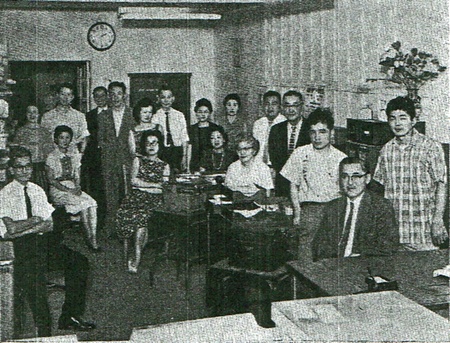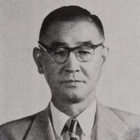Kato Shinichi, who served as Secretary General of the World Federalist Asian Conference held in Hiroshima in November 1952 and as Secretary General of the Hiroshima Prefectural Headquarters of the United Nations Association of Japan, gave up his position in the peace movement in Japan and returned to the United States in April 1953.
As of 1961, his biography from 1953 onwards was as follows:
In 1953, he returned to the US as a correspondent for the Sankei Shimbun, and later joined the Shin Nichibei Shimbunsha, where he gradually brought his family over to the US, and in 1958 obtained permanent residency in the US, and is currently the company's editor-in-chief (note: 1961). He edited the company's 1955 and 1959 editions of the Directory of Japanese Americans in America, and in 1960 edited the 70-Year History of Japanese in Southern California, and was awarded the Green and White Ribbon by the Agricultural Association of Japan in the same year at the Japan-US Centennial Commemoration. From that year through 1961, he also edited the "100-Year History of Japanese Americans in America" and the "Gentleman's Directory of the Development of Japanese Americans in America," both published by the Shin Nichibei Shimbunsha.
From Sankei correspondent to editor-in-chief of New Japan Newspaper Company
According to the above biography, he returned to the US in April 1953 and was involved in editing the 1955 edition of the New Japan America Newspaper Company's Directory of Japanese Americans in America, so it seems likely that he was a Sankei Shimbun correspondent for only a year or two. Why did Kato, who was in Hiroshima, travel to the US as a Sankei Shimbun correspondent, and why did he immediately move to the New Japan America Newspaper Company in Los Angeles?
The exact reason is unclear, but it may have been assumed that he would move to the New Japan America Newspaper Company. This is because the company had a deep relationship with the Sankei Shimbun. This is written in the introductory article on the New Japan America Newspaper Company in the book "A Hundred Years of Japanese Americans in the United States," which Kato himself edited, but before touching on this relationship, I would like to explain about the company.
Shin Nichibei Shimbunsha was founded in April 1947 after the war by Kenichi Momii, who came from Hawaii, as a weekly newspaper in Los Angeles, which later became a daily newspaper and competed with the Rafu Shimpo and California Mainichi, which were revived after the war. Momii was highly praised for publishing the "Directory of Japanese Americans in America" at the same time as the newspaper, but he returned to Japan to start a new business and handed over management to lawyer Saburo Kido.
During the war, as president of the Japanese American National Citizens League, Kido took the lead in fighting for the safety and rights of Japanese Americans, arguing that Japanese Americans living in the United States should pledge loyalty to the United States, but this sometimes led to him being attacked by radical Japanists.
Even after Mr. Kido, who had roots in Hiroshima, became the new president, the "Directory of Japanese Americans in America" was published in 1955, and this is thought to have been the basis for "A Centennial History of Japanese Americans in America: A Directory of Their Development," which Kato later wrote and edited as the company's chief editor.
Who knew Kato during his time at New Japan and America?
The relationship between the New Nichibei Newspaper Company and the Sankei Shimbun can be seen in the article introducing the company in the "Centennial History of Japanese Americans in the United States."
In 1952, during the time of the first president, Momii, the company co-hosted the "Pioneer Home Country Tourist Group" with the Sankei Shimbun, which led to a partnership between the two companies, with photoengraving and type-casting technicians sent from Sankei Shimbun along with machinery. Young reporters were also sent from the company to act as correspondents and help with the paper's revamp.
Furthermore, as the Sankei Shimbun had been taking care of Japan's representative for the Miss Universe pageant held in Long Beach, California every year, it received cooperation from Shin Nichibei as its base in California, and the Shin Nichibei Newspaper Company in turn received articles from Sankei and was also assisted in producing the newspaper, forming a cooperative relationship.
Kato changed his status from a Sankei correspondent to a reporter for the New Japan Newspaper, and then traveled all over the United States to edit "The Centennial History of Japanese Americans in the United States." To repeat, the trigger for this series on Kato Shinichi was to explore what kind of activities he was involved in at that time.
As our research progressed, we learned quite a lot about Kato's life, but unfortunately, the records of his travels around the United States to visit the first generation of Japanese immigrants remained unknown because the New Japan America Newspaper Company was short-lived and it was difficult to find people who were familiar with the period.
However, when I read the article introducing Shin Nichibei Shimbun again, I realized that at the time there were several reporters from Sankei's Tokyo headquarters who, like Kato, had worked for Shin Nichibei Shimbun as special correspondents, so I thought I might be able to find a former Sankei Shimbun reporter who was there at the time and get some information about Kato from them.

After searching the Internet using a few keywords, I came across just one essay in the Japan National Press Club Newsletter (April 10, 2009 issue) written by Abe Muneta, a former Sankei Shimbun reporter.
According to the essay, Abe was sent to Los Angeles by the head office in the 1960s for language training and helped produce the newspaper "Shin-Nichibei." Abe wrote, "(Shin-Nichibei's) president, Saburo Kido, was the chairman of the JACL (Japanese American Citizens League), but he told me bit by bit about how he was attacked by pro-Japan people and seriously injured after proposing a policy that Japanese Americans should show their loyalty by joining the U.S. military."
In an article introducing our company (Shin Nichibei Shimbunsha) in "The Centennial History of Japanese Americans in the United States," the names of two reporters from Sankei who came at the time, Shinichi Yamada and Takeshi Fujisaki, were mentioned, but Mr. Abe was not. However, thinking that Mr. Kato and Mr. Abe might have been in the Shin Nichibei office at roughly the same time, we looked for Mr. Abe's location and contact information.
Fortunately, I was able to get contact information for Mr. Abe through a friend who is a member of the Japan National Press Club. I called him and explained the situation, and he readily agreed to meet me in person to hear what he had to say.
Mr. Abe, who lives along the Denentoshi Line, came out to the nearest station and sat down at a nearby coffee shop to tell me stories from half a century ago. Mr. Abe, who served as the political chief and correspondent in New York and Washington, reminisced nostalgically about his youth in Los Angeles and talked about how President Kido was a great man who was active at the time, bringing together Japanese Americans.
Abe spent his middle and high school years in Ujina, Hiroshima, and says that Kido, who has roots in Hiroshima, treated him well.
The conversation also touched on the state of the Shinnichibei office at the time, the production of the newspaper, etc. However, unfortunately, it seemed that by the time Abe was transferred to Los Angeles after Takeshi Fujisaki and became involved in the work of Shinnichibei, Shinichi Kato had already finished editing "The Centennial History of Japanese Americans in the United States" and had left Shinnichibei.
(Titles omitted)
© 2021 Ryusuke Kawai






